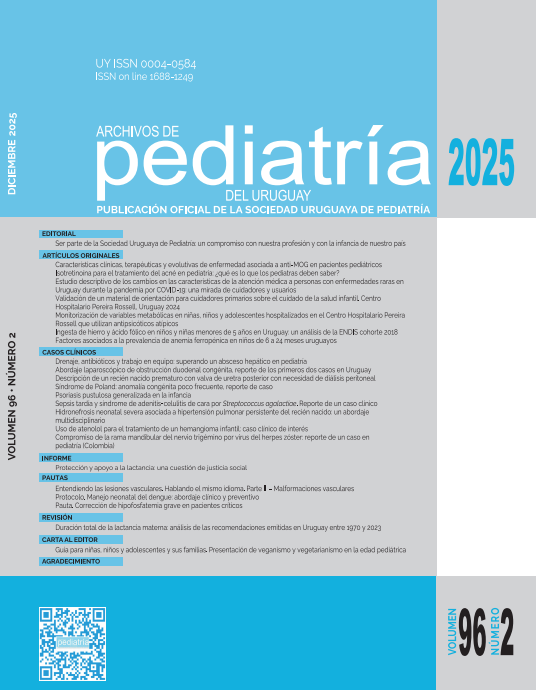Resumen
Introducción: en 2023, docentes de la Unidad Académica de Pediatría C, Facultad de Medicina, elaboraron un material informativo sobre temas relevantes de salud.
Objetivos: validar este material dirigido a cuidadores primarios de niños hospitalizados en el Centro Hospitalario Pereira Rossell.
Metodología: estudio observacional transversal que incluyó a cuidadores primarios mayores de 18 años de edad de niños/as y adolescentes hospitalizados durante los meses de julio a setiembre de 2024. Los participantes evaluaron el material en términos de atractividad, aceptación, entendimiento, identificación e inducción al cambio mediante preguntas cerradas (dicotómicas y escala de Likert) y abiertas.
Resultados: se realizaron 220 entrevistas. La mediana de edad de los cuidadores primarios fue 30 años, de género femenino 198 (90%) y madres 176 (80%). A 215 (98%) personas les pareció interesante el material. Consideraron probable leerlo por su cuenta 179 (81,4%). Las investigadoras interpretaron que la expresión de las entrevistadas coincidía con el mensaje en 90,9%. Los cuidadores consideraron que entendían el mensaje en el 92,7% de los casos. Consideraron probable que le pasara la situación planteada en el material 191 personas (86,8%). Refirieron que era muy probable que este material sirviera para modificar su accionar el 40%.
Conclusiones: los resultados mostraron que el material educativo validado fue aprobado por la mayoría de las personas, cumpliendo así los objetivos propuestos en base a los cinco criterios utilizados. Asimismo, la retroalimentación recibida durante el proceso de validación permitió reconocer áreas de mejora. Esta validación proporciona una base sólida para futuras investigaciones y mejoras en el material educativo con el objetivo de promover prácticas de salud óptimas y mejorar la calidad del cuidado infantil.
Citas
Hahn R, Truman B. Education Improves Public Health and Promotes Health Equity. Int J Health Serv 2015; 45(4):657-78. doi: 10.1177/0020731415585986.
Müller M, Jürgens J, Redaèlli M, Klingberg K, Hautz W, Stock S. Impact of the communication and patient hand-off tool SBAR on patient safety: a systematic review. BMJ Open 2018; 8(8):e022202. doi: 10.1136/bmjopen-2018-022202.
Mendoza Y, Barría M. La comunicación en salud y la necesidad de integración interdisciplinaria. Rev Cuba Inf En Cienc Salud 2021; 32(3):e1692.
Franco A, Alzate T, Granda D, Hincapié L, Muñoz L. Validación de material educativo del programa "Niñ@s en Movimiento" para el tratamiento de la obesidad infantil. Rev Fac Nac Salud Pública 2018; 36(3):109-19. doi: 10.17533/udea.rfnsp.v36n2a11.
Tavares P, Hamamoto P, Ferreira A, Avila M. Construction and Validation of Educational Material for Children with Hydrocephalus and Their Informal Caregivers. World Neurosurg 2018; 114:381-90. doi: 10.1016/j.wneu.2018.03.082.
Sena J, Silva I, Lucena S, Oliveira A, Costa I. Validation of educational material for the care of people with intestinal stoma. Rev Lat Am Enfermagem 2020; 28:e3269. doi: 10.1590/1518-8345.3179.3269.
Fritsch T, Bueno K, Silva L, Saraiva T, Silva U, Rabin E. Validação de "podcast" como meio de promoção de saúde na oncologia. Rev Recien 2023; 13(41):158-69. doi: 10.24276/rrecien2023.13.41.158-169.
Protheroe J, Estacio E, Saidy S. Patient information materials in general practices and promotion of health literacy: an observational study of their effectiveness. Br J Gen Pract 2015; 65(632):e192-7. doi: 10.3399/bjgp15X684013.
Ziemendorff S, Krause A. Guía de validación de materiales educativos (con enfoque en materiales de educación sanitaria). Chiclayo: Programa de Agua y Saneamiento PROAGUA/GTZ, 2003.
Awaisu A, Mohamed M, Noordin N, Mohamad N. Impact of a pharmacy continuing education (CE) intervention on self-reported implementation of knowledge and skills gained in tobacco cessation services: application of the theory of planned behaviour. BMC Health Serv Res 2014; 14(1):1-8.
Patel S, Cain J, Townsend K, Thomson L, Black E. Ensuring that instructional materials are effective and relevant to learners: The Design Process at the Center for Online Teaching and Learning (COTL). J Contin Educ Nurs 2016; 47(6):269-75.
Davis D, Mazmanian P, Fordis M, Van Harrison R, Thorpe K, Perrier L. Accuracy of physician self-assessment compared with observed measures of competence: a systematic review. JAMA 2006; 296(9):1094-102. doi: 10.1001/jama.296.9.1094.
Glanz K, Bishop D. The role of behavioral science theory in development and implementation of public health interventions. Annu Rev Public Health 2010; 31:399-418. doi: 10.1146/annurev.publhealth.012809.103604.
Organización Panamericana de la Salud. Guía para el diseño, utilización y evaluación de materiales educativos de salud. Washington, DC: OPS, 2009.
Coulter A, Ellins J. Effectiveness of strategies for informing, educating, and involving patients. BMJ 2007; 335(7609):24-7. doi: 10.1136/bmj.39246.581169.80.
Campbell M, Fitzpatrick R, Haines A, Kinmonth A, Sandercock P, Spiegelhalter D, et al. Framework for design and evaluation of complex interventions to improve health. BMJ 2000; 321(7262):694-6. doi: 10.1136/bmj.321.7262.694.
Krueger R, Casey M. Focus groups: a practical guide for applied research. 5 ed. Thousand Oaks: Sage, 2015.
Feinberg M. The internal structure and ecological context of coparenting: a framework for research and intervention. Parent Sci Pract 2003; 3(2):95-131. doi: 10.1207/S15327922PAR0302_01.
Hochschild A, Machung A. The second shift: Working families and the revolution at home. New York: Penguin Books, 2012.

Esta obra está bajo una licencia internacional Creative Commons Atribución 4.0.
Derechos de autor 2025 Archivos de Pediatría del Uruguay


